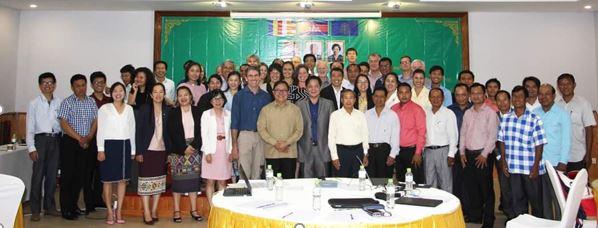Towards a sustainable fresh vegetable supply chain in Cambodia and Lao PDR
Blog prepared by Mr.Jeremy Badgery-Parker
Our project on improving market engagement, post-harvest management and productivity of the Cambodian and Lao PDR vegetable industries is drawing to a close. This month, the project team have been busy finalising 4 years’ of research and development activities following our end of project review in December.

End of project review team photo.
In both Cambodia and Lao PDR, there is strong market demand for local, high quality, safe fresh vegetables and this is exacerbated during the wet season as smallholder farmers struggle to produce economic yields of high value vegetables in the hot wet conditions. These vegetable industries also share some other challenges. Postharvest losses can be as high as 40% and produce falls short of the quality and safety demands of modern consumers.
The usual response to protective cropping is typically low cost tunnels or hoop houses. These structures, however, are rarely suitable in warm to hot conditions, especially in the tropics, and the excessive internal temperatures and poor growing conditions are a long term disaster for a fledging vegetable industry.
Recognising the importance of keeping costs down, a new design of protective structure was developed and then tested in the field in two provinces of Cambodia (Kampot and Kandal) and two provinces of Laos (Vientiane and Champasak). The objective behind this exciting research for development project was to create a structure that is economically viable, provides effective protection from heavy and excess rain and still provides suitable growing conditions, in particular, avoiding the excess temperatures that are created in cheap tunnel houses.
The simple design features several elements:
- a two module system results in a permanent roof gap to vent heat
- the structure is given sensible height to improve air exchange and venting
- the width of the structure minimises adverse crop impacts from rain entry through open sides and accommodates an efficient layout internally
- the whole design facilitates a wide choice of construction materials and utilises available material sizes to minimise building costs
- a moveable internal shade screen can provide additional protection for leafy crops and supports year-round production – even during the hottest months
- The outside of the structure can be readily insect screened to reduce pest and disease pressure without compromising the internal growing environment
- The use of modules enables incremental expansion to better fit smallholder budgets

Novel project greenhouse providing backdrop to research and extension activities in Laos. Note roof gap venting, wide span, height, internal shade and side netting.
Parallel to work on addressing the wet season production challenges, the team have been conducting a number of supply chain and market analyses and investigating critical food safety and post harvest losses to devise simple interventions.
Produce damage, particularly for leafy vegetables such as Bok Choy, during transport is a significant factor in post-harvest loss. The use of collapsible plastic crates have been shown to be a highly cost effective intervention, but challenges remain surrounding the logistics within different markets concerning the collection and return of crates. For another important crop – tomato – undesirable ripening is a major concern during transport. Collaborative research with in-country partners has shown that the use of ethylene absorbent satchels can offer significant benefit for supply chains of around 7 days, whereas improved fruit grading may reduce any benefit in a shorter supply chain.
Currently, the project team is conducting evaluation and assessment conversations with smallholder farmers who were actively involved in the field research as well as other farmers who were observing from the sidelines. Additionally, a pilot ‘open publication portal’ for basic trial activity reports, short communications and research notes is being devised to enable easy publication and sharing of research results when journal publication is not realistic or is premature.
The next critical step in the development of a sustainable greenhouse vegetable industry in these countries is to expand the outreach of these interventions, couple this with capacity development training and implement technologies in real time with stakeholders. It is hoped that this work will be funded in the coming years to capitalise on the substantial gains made to date.
The project is led by Mr.Jeremy Badgery-Parker from Centre for Global Food and Resources (GFAR) in collaboration with the other partners in Cambodia (GDA, CARDI, iDE and SNV) and Australia (Charles Sturt University and NSW Department of Primary Industries . The project is funded by Australian Centre for International Agricultural Research (ACIAR).
